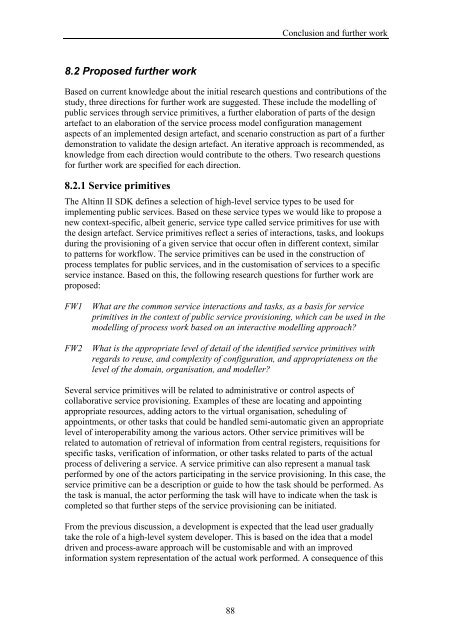Multi-channel provisioning of public services - Department of ...
Multi-channel provisioning of public services - Department of ...
Multi-channel provisioning of public services - Department of ...
Create successful ePaper yourself
Turn your PDF publications into a flip-book with our unique Google optimized e-Paper software.
Conclusion and further work<br />
8.2 Proposed further work<br />
Based on current knowledge about the initial research questions and contributions <strong>of</strong> the<br />
study, three directions for further work are suggested. These include the modelling <strong>of</strong><br />
<strong>public</strong> <strong>services</strong> through service primitives, a further elaboration <strong>of</strong> parts <strong>of</strong> the design<br />
artefact to an elaboration <strong>of</strong> the service process model configuration management<br />
aspects <strong>of</strong> an implemented design artefact, and scenario construction as part <strong>of</strong> a further<br />
demonstration to validate the design artefact. An iterative approach is recommended, as<br />
knowledge from each direction would contribute to the others. Two research questions<br />
for further work are specified for each direction.<br />
8.2.1 Service primitives<br />
The Altinn II SDK defines a selection <strong>of</strong> high-level service types to be used for<br />
implementing <strong>public</strong> <strong>services</strong>. Based on these service types we would like to propose a<br />
new context-specific, albeit generic, service type called service primitives for use with<br />
the design artefact. Service primitives reflect a series <strong>of</strong> interactions, tasks, and lookups<br />
during the <strong>provisioning</strong> <strong>of</strong> a given service that occur <strong>of</strong>ten in different context, similar<br />
to patterns for workflow. The service primitives can be used in the construction <strong>of</strong><br />
process templates for <strong>public</strong> <strong>services</strong>, and in the customisation <strong>of</strong> <strong>services</strong> to a specific<br />
service instance. Based on this, the following research questions for further work are<br />
proposed:<br />
FW1<br />
FW2<br />
What are the common service interactions and tasks, as a basis for service<br />
primitives in the context <strong>of</strong> <strong>public</strong> service <strong>provisioning</strong>, which can be used in the<br />
modelling <strong>of</strong> process work based on an interactive modelling approach?<br />
What is the appropriate level <strong>of</strong> detail <strong>of</strong> the identified service primitives with<br />
regards to reuse, and complexity <strong>of</strong> configuration, and appropriateness on the<br />
level <strong>of</strong> the domain, organisation, and modeller?<br />
Several service primitives will be related to administrative or control aspects <strong>of</strong><br />
collaborative service <strong>provisioning</strong>. Examples <strong>of</strong> these are locating and appointing<br />
appropriate resources, adding actors to the virtual organisation, scheduling <strong>of</strong><br />
appointments, or other tasks that could be handled semi-automatic given an appropriate<br />
level <strong>of</strong> interoperability among the various actors. Other service primitives will be<br />
related to automation <strong>of</strong> retrieval <strong>of</strong> information from central registers, requisitions for<br />
specific tasks, verification <strong>of</strong> information, or other tasks related to parts <strong>of</strong> the actual<br />
process <strong>of</strong> delivering a service. A service primitive can also represent a manual task<br />
performed by one <strong>of</strong> the actors participating in the service <strong>provisioning</strong>. In this case, the<br />
service primitive can be a description or guide to how the task should be performed. As<br />
the task is manual, the actor performing the task will have to indicate when the task is<br />
completed so that further steps <strong>of</strong> the service <strong>provisioning</strong> can be initiated.<br />
From the previous discussion, a development is expected that the lead user gradually<br />
take the role <strong>of</strong> a high-level system developer. This is based on the idea that a model<br />
driven and process-aware approach will be customisable and with an improved<br />
information system representation <strong>of</strong> the actual work performed. A consequence <strong>of</strong> this<br />
88
















